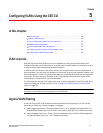Dell Converged Enhanced Ethernet Administrator’s Guide 29
53-1002116-01
Configuring IP static routes
4
Recursive IP static routes
In a recursive IP static route, only the next hop is specified. The output interface is derived from the
next hop. A recursive IP static route is valid (that is, it is a candidate for insertion in the routing
table) only when the specified next hop resolves, either directly or indirectly, to a valid output
interface, provided the route does not self-recurse, and the recursion depth does not exceed the
maximum IPv4 forwarding recursion depth. Fabric OS v6.3.1_cee supports one level of recursion.
Beyond this level of recursion the routes are held as inactive routes.
Dell does not recommend manually configuring a self-recursive IP static route, although it is not
prohibited. However, a recursive IP static route that has been inserted in the routing table may
become self-recursive as a result of some transient change in the network learned through a
dynamic routing protocol. If this occurs, the fact that the IP static route has become self-recursive is
detected and is removed from the routing table, although not from the configuration. A subsequent
network change may cause the IP static route to no longer be self-recursive, in which case it is
reinserted in the routing table.
The following example specifies that all destinations with address prefix 1.1.1.1/32 are reachable
via the host with address 2.2.2.2.
switch(config)#ip route 1.1.1.1/32 2.2.2.2
Floating IP static routes
Floating IP static routes act as a alternative path to dynamic routes learned through configured
routing protocols. A floating IP static route is configured with a higher administrative distance than
the dynamic routing protocol. As a result, the dynamic route learned through the routing protocol is
always used in preference to the floating IP static route. If the dynamic route learned through the
routing protocol is lost, the floating IP static route is used in its place.
A floating IP static route must be configured with an administrative distance that is greater than the
administrative distance of the dynamic routing protocol, because routes with smaller
administrative distances are preferred. For example, if your Open Shortest Path First (OSPF)
protocol is configured with an administrative distance of 120, specify an administrative distance
greater than 120 for your floating IP static route.
The following example defines a floating IP static route that shows all destinations with address
prefix 1.1.1.1/32 are reachable through internal 10 Gbps interface 0/1:
switch(config)#ip route 1.1.1.1/32 intengigabitethernet 0/1 121
Displaying and clearing IP static routes
To display the current IP routing information and clear the assigned settings, perform the following
procedure from EXEC mode.
1. Display a summary of the IP routing table.
switch>show ip route summary
Route Source Networks Subnets Overhead Memory (bytes)
connected 0 1 64 160
static 1 1 128 320
internal 1 1180
Total 2 2 192 1660


















